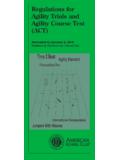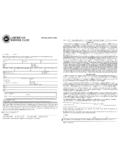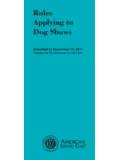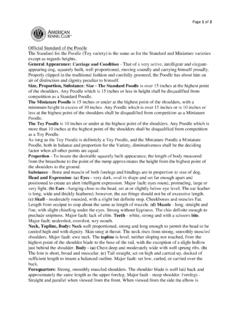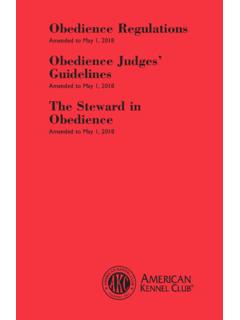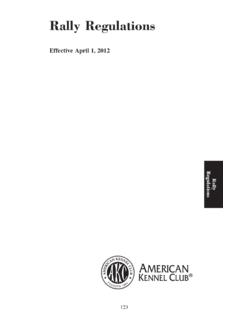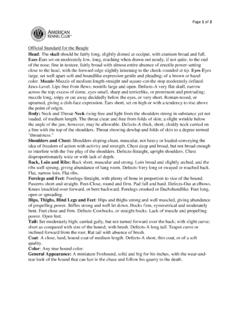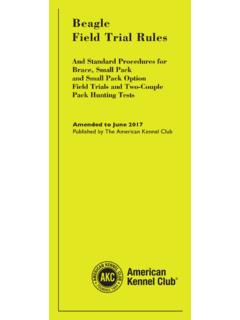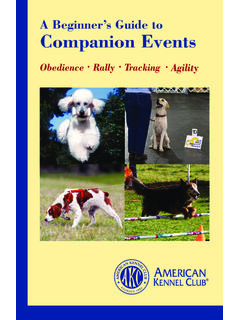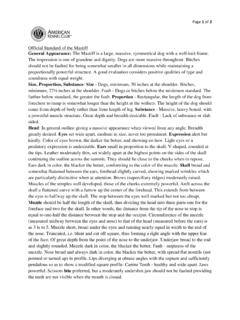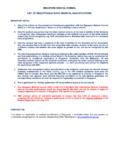Transcription of Regulations for Agility Trials and Agility Course Test …
1 Regulations forAgility Trials andAgility Course Test(ACT)Amended to January 2, 2018 Published by The American Kennel ClubRevisions to theRegulations for Agility TrialsEffective June 1, 2018 This insert is issued as a supplement to theRegulations for Agility TrialsAmended to April 1, 2017 CHAPTER 11 Regulations FOR Agility TRIALSPREMIER CLASSESC hapter 11 Section 2. Eligibility. The Premier class has a single class level. Dogs Eligible to enter Novice, Open, Excellent or Master level classes may enter the Premier InsertIssued: January 2018 REAGIL (07/17)1 Table of ContentsChapter 1 Regulations for Agility 1. Purpose ..5 Section 2. Agility Trials Defined ..5 Section 3. Eligibility of Dogs ..6 Section 4. Eligibility to Hold Agility Trials ..7 Section 5. Making Application ..7 Section 6. Agility Trial Secretary and Agility Trial 7. Appointment of the Event Committee ..8 Section 8. Stewards, Timers, Scribes ..8 Section 9. Premium Lists ..8 Section 10. Risk ..10 Section 11.
2 Entry Forms ..10 Section 12. Entry Methods ..10 Section 13. Entry Limits ..11 Section 14. Opening and Closing Dates ..11 Section 15. Paper Entry Forms Per Envelope ..11 Section 16. Entry Acceptance Methods ..111. First Random Draw ..13 Section 17. Duplicate Entries ..14 Section 18. Event Limit Options, Judge Assignment Changes and Load Balancing Entries ..15 Section 19. Running Order ..16 Section 20. Move-ups ..16 Section 21. Entry of Ineligible Dog ..17 Section 22. Declining Entries and Excusing a Dog from the Trial ..18 Section 23. Handling Dog Aggression ..18 Section 24. Ribbons and Rosettes ..19 Section 25. Catalogs ..20 Section 26. Scorekeeping Requirements ..21 Section 27. Recording 28. Submission of Records ..22 Section 29. Cancellation of Awards ..23 Section 30. Approval of Judges ..23 Section 31. Judges Responsibilities ..23 Chapter 2 Classes, Titles, and Height Divisions ..25 Section 1. Classes ..25 Regular Titling Classes ..26 Section 2. Regular Agility Titles.
3 27 Section 3. Recognized Achievement ..28 Section 4. Height, Divisions, Measurement, Measurement Devices ..30 Section 5. Jump Height Card ..312 Chapter 3 Obstacle Specifications and Performance Requirements ..34 Section 1. Obstacle and Jump Specifications ..34 Section 2. Obstacle Performance ..34 Section 3. Obstacles ..341. A-Frame ..342. Dog Walk ..343. Seesaw ..354. Pause Table ..355. Open Tunnel ..356. Closed Tunnel ..367. Weave Poles ..368. Bar Jumps ..379. Panel Jump ..3810. Double Bar Jump ..3811. Triple Bar Jump ..3912. Tire Jump ..3913. Broad Jump ..4014. Other Jump Wings ..4116. Wall Jump ..42 Chapter 4 General Course and Trial Requirements 43 Section 1. Course Size and Suitability & Facilities ..43 Section 2. Surfaces, Matting ..43 Section 3. Course Requirements ..43 Section 4. Obstacle and Jump Positions ..43 Section 5. Approach Angles ..44 Section 6. Preparing a Ring for Agility ..44 Section 7. Course Distances, Times ..44 Section 8.
4 Walk-throughs, Warm-ups ..44 Section 9. Collars ..44 Section 10. Leashes ..45 Section 11. Hair Tie Back Policy ..45 Section 12. Handling Aids ..45 Section 13. Handler s Position ..45 Section 14. Starting and Completion ..45 Section 15. Training on Show Grounds ..46 Section 16. Clothing/Identification ..46 Chapter 5 General Scoring Criteria ..47 Section 1. Maximum Score, Qualifying Score ..47 Section 2. Placements, Tied Scores ..47 Section 3. Course Time Deductions ..47 Section 4. Faults ..47a. Refusals and Run-outs ..47b. Wrong Course ..48c. Pause Table Faults ..48d. Outside Assistance ..48e. Lead Out Advantage ..48 Section 5. Mandatory Elimination (NQ) ..49 Section 6. Mandatory Excusals ..49 Chapter 6 Standard Classes ..51 Section 1. Criteria ..51 Section 2. Novice A and B Agility Standard Class ..51 Section 3. Open Agility Standard Class ..51 Section 4. Excellent Agility Standard Class ..52 Section 5. Master Agility Standard Class ..523 Chapter 7 Jumpers With Weaves Classes.
5 55 Section 1. Purpose ..55 Section 2. Novice A and B JWW Class ..55 Section 3. Open JWW Class ..55 Section 4. Excellent JWW Class ..56 Section 5. Master JWW Class ..56 Chapter 8 Preferred Classes ..58 Section 1. Purpose ..58 Section 2. Standards ..58 Section 3. Eligibility ..58 Section 4. Classes ..58 Section 5. Preferred Agility Titles ..60 Section 6. Recognized Achievement ..60 Section 7. Preferred Agility Excellent Title (PAX) ..62 Section 8. Preferred Agility Champion Title (PACH)..63 Section 9. Height Divisions ..64 Section 10. Scoring Criteria ..64 Chapter 9 Fifteen and Send Time (FAST) Class ..66 Section 1. Purpose ..66 Section 2. Definition ..66 Section 3. Additional Class Information ..69 Section 4. Performance Requirements for All Classes ..70 Section 5. FAST Class Eligibility ..72 Section 6. Novice A & B FAST and Novice FAST Preferred Class ..72 Section 7. Open FAST and Open FAST Preferred Class ..72 Section 8. Excellent & Master FAST and Excellent & Master FAST Preferred Class.
6 72 Section 9. Titles and Requirements ..73 Chapter 10 Time 2 Beat (T2B) Class ..75 Section 1. Purpose ..75 Section 2. Definition ..75 Section 3. Eligibility ..75 Section 4. Performance Standards ..75 Section 5. Maximum Course Times (MCT) ..75 Section 6. Scoring Criteria ..75 Section 7. Catalog Requirements ..77 Section 8. Titles ..77 Section 9. Minimum Obstacle Requirements ..77 Chapter 11 Premier Classes ..78 Section 1. Purpose ..78 Section 2. Eligibility ..78 Section 3. Performance Standards ..78 Section 4. Obstacle and Jump Positions ..79 Section 5. Approach Angles ..79 Section 6. Titles ..79 Chapter 12 National Agility Champion Title ..80 Section 1. National Agility Champion Titles ..80 Section 2. National Agility Champion Defined ..80 Section 3. Dogs That May Compete ..804 Chapter 13 Versatile Companion Dog ..81 Section 1. Versatile Companion Dog Titles ..81 Section 2. Versatile Companion Champion Title (VCCH) ..81 Chapter 14 Non-Regular Agility Classes International Sweepstakes Class (ISC).
7 82 Section 1. Purpose ..82 Section 2. Eligibility of Dogs ..82 Section 3. Eligibility to Hold the ISC Class ..82 Section 4. Ribbons, Rosettes and Awards ..82 Section 5. Recording 6. ISC 7. Jump Heights ..82 Section 8. Judges ..83 Section 9. Obstacle Specifications ..83 Section 10. Course and Trial Requirements ..84 Section 11. Equipment Requirements ..85 Standard ISC Class ..85 Jumpers ISC Class ..85 Section 12. Course Distances and Times ..86 Section 13. Scoring ..87 Section 14. Placements and Tied Scores ..87 Section 15. Course Time Penalties ..87 Section 16. Maximum Course Time ..87 Section 17. Standard 18. Refusal Faults ..87 Section 19. Elimination Faults ..88 Section 20. Excusals ..88 Chapter 15 Regulations for Agility Course Test (ACT) ..89 Section 1. Purpose..89 Section 2. ACT Event ..89 Section 3. Eligibility of Dogs ..89 Section 4. Holding ACT Events ..89 Section 5. Ribbons, Rosettes and Awards ..89 Section 6. Submission of Results and Reports.
8 90 Section 7. Jump Height Divisions ..90 Section 8. Judges/Evaluators ..90 Section 9. Course Size, Suitability and Facilities ..90 Section 10. Course Requirements ..90 Section 11. Obstacle and Jump Positions..90 Section 12. Approach Angles..90 Section 13. ACT1 ..90 Section 14. ACT2 ..91 Section 15. Obstacles for ACT1 and ACT2 ..925 Chapter 1 Regulations for Agility Trials Section 1. Purpose. The purpose of AKC Agility Trials is to afford owners the opportunity to demonstrate a dog s physical ability/soundness and willingness to work with its handler under a variety of conditions. The program begins with basic entry-level Agility , and progresses to more complex levels that require dogs to demonstrate higher levels of training and interaction with their handlers. Agility results in a better rounded, conditioned dog, provides good basic training for search and rescue dogs, demonstrates good training and citizenship and has excellent spectator appeal. Agility Trials are sporting events and all participants should be guided by the principles of good sportsmanship both in and outside the trial Course .
9 Section 2. Agility Trials Defined. A member Agility trial is a trial at which qualifying scores toward titles are awarded, given by a club or association, which is a member of the American Kennel Club . A licensed Agility trial is a trial at which qualifying scores toward titles are awarded, given by a club which has been licensed by the AKC to hold the trial. In addition to Agility clubs, any AKC club may be granted permission to hold Agility Trials provided the club holds the event(s) for which it was originally formed at least once every two years. FSS breeds with AKC approved parent clubs may become licensed to hold Agility Trials . Sanctioned Agility Trials are informal events at which dogs may participate but not for AKC titles, held by a club or association by obtaining the sanction of the American Kennel Club. Generally, sanctioned events are held by clubs to qualify for approval to hold licensed or member club events. Agility Trials may not be held closer than 100 miles in distance on the same day except a club or association may be licensed to hold an Agility trial within 100 miles of another club or association which has established its licensed trial on the same date only if, in each instance, it obtains the written permission of the club or association with the established date and submits the written permission along with its trial application.
10 However, there may not be two all-breed Agility Trials on the same day at the same location. Specialty clubs holding a limited Agility trial for all AKC recognized breeds may accept entries of dogs of their own breed first then accept entries from all breeds and dogs listed with AKC Canine Partners (if offered) until the entry limit specified in the premium list is reached. Clubs have the option to allow dogs listed with AKC Canine Partners to participate at all-breed AKC Agility Trials . An AKC-recognized specialty club may offer a single breed specialty Agility trial in conjunction with a club s all-breed trial, sharing the same date, show site, equipment and judges. Specialty trial participants shall be excluded from competing in the adjoining all-breed trial. Both Agility Trials may be run together; however, each club is required to maintain separate event records. An AKC recognized single breed specialty club may offer two single breed specialties in one day on the same show site 6 CHAPTER 1 Section 2for their breed.
